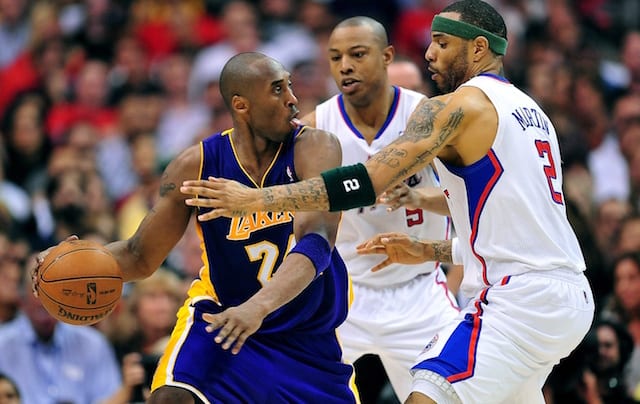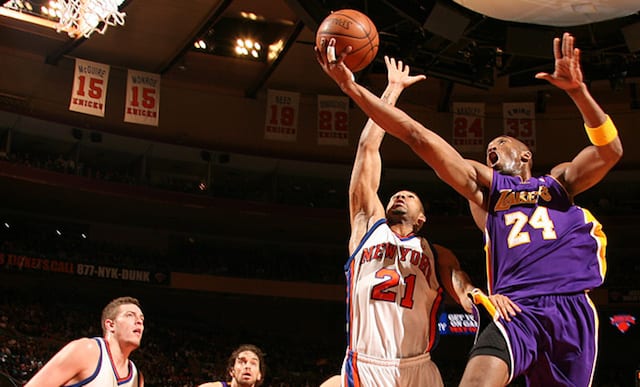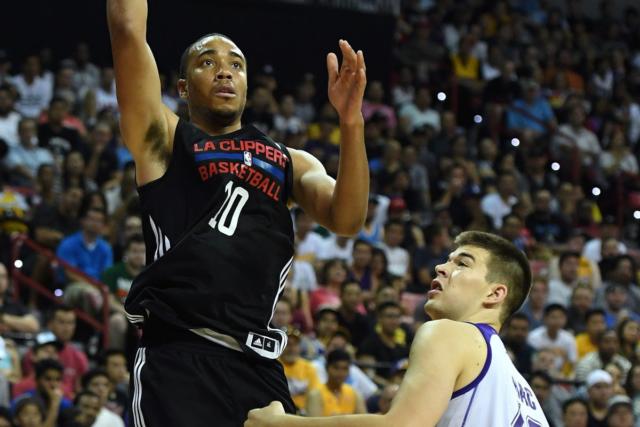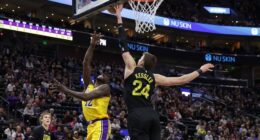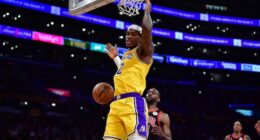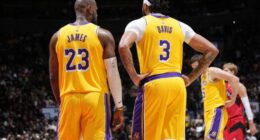Los Angeles is one of the densest sports cities in America. As it currently stands there are 10 Los Angeles sports teams with two each in the NBA, NFL, MLB, NHL and MLS.
When it comes to the LA basketball teams, however, the rivalry has become much more fierce in recent seasons as any games between the Los Angeles Lakers and Los Angeles Clippers have the atmosphere of a playoff game.
While that is the case now, the rivalry between the two L.A. basketball franchises may not have ever begun if the teams never converged on the same city. Neither the Lakers or Clippers began in L.A.
So many may be wondering, why does Los Angeles have two basketball teams in the first place?
The History of the Los Angeles Professional Basketball Teams
So how did Los Angeles get two basketball teams in the NBA? The answer for each team is different and requires a deep look into the history of both the Lakers and Clippers.
LA Basketball Teams: The Lakers
Lakers franchise history begins in 1947 when Ben Berger and Morris Chalfen bought the recently-disbanded Detroit Gems, moved them to Minnesota, and named them the Minneapolis Lakers after the state’s nickname, the ‘Land of 10,000 Lakes.’
Behind the NBA’s first superstar, George Mikan, the Lakers won five championships from 1948-1954, making them the premier franchise of the early days of the NBA. However, Mikan’s retirement in 1954 set the Lakers down their path of relocating to Los Angeles.
Both the team’s record and attendance would drop over the next few seasons. Even a brief return from Mikan during the 1956 season couldn’t help things like the Hall of Famer would struggle and retire permanently after the season. The next big change came in 1957 when Minnesota political figure Bob Short purchased the team from Berger and Chalfen.
Unfortunately, the change in ownership would not bring about a change in success for the Lakers as the franchise continued to struggle. They won just 19 games during the 1958 season, though that failure would gift the team with the top pick in the NBA Draft.
The Lakers the No. 1 overall pick to select their next great superstar in University of Seattle forward Elgin Baylor, who would immediately become one of the NBA’s best players.
Baylor won Rookie of the Year and was named co-MVP of the All-Star Game in 1959 and would help the Lakers improve their record to 33-39. Baylor also helped with the team’s popularity in Minneapolis as the Lakers’ attendance doubled and it seemed as if there was a chance the team could remain in Minnesota.
However, the following year would ultimately be the final Minneapolis Lakers season.
The team’s record regressed to 25-50 and Short was openly frustrated with the lack of popularity and support for the franchise in Minneapolis. Short spoke openly about how he had lowered ticket prices to levels that were as cheap as any other city in the NBA and even hired former Lakers star Jim Pollard as the team’s new head coach, hoping that would spark more interest as well.
But nothing seemed to work and making a move more intriguing to Short was the level of crowds the Lakers were seeing in neutral site games. The Lakers played the Philadelphia Warriors in the very first NBA game in the city of Los Angeles on February 1, 1960, and drew a crowd of over 10,000 fans at the Los Angeles Memorial Sports Arena.
Just a couple of weeks later, the Lakers would play the St. Louis Hawks on back-to-back nights in L.A. Those two games against the Hawks didn’t do quite the same attendance numbers as the Warriors matchup, averaging around 6,000 fans for both nights.
But it was still more than enough for Short who said afterward that if the NBA would approve it, the Lakers would most likely be moving their operations to Los Angeles.
Even with an apparent desire to move the Lakers to become a Los Angeles sports team, and a formal application submitted, hurdles remained for Short.
Short wanted lower rent at the L.A. Memorial Coliseum which was an issue, but the bigger obstacle was an existing expansion bid by the proposed Los Angeles Jets. Had the NBA decided to bring on the brand new franchise to Los Angeles, Short could have moved the Lakers to San Francisco instead, which would have completely changed the history of many franchises around the NBA.
Ultimately, however, the Jets decided to join American Basketball League, opening the door for Short and the Lakers to make their desired move to Los Angeles.
When did the Minneapolis Lakers move to LA?
On April 27, 1960, the NBA granted Bob Short approval to move the Lakers from Minneapolis to Los Angeles. The move would be official “providing a satisfactory schedule can be drawn.” That proved to be no issue at all for Short who would offer the league 70 potential home dates, which far and away exceeded the requisite 28.
The majority of those games were to be played at the Sports Arena, but other games would be played at Cal State University, Los Angeles, and some other neutral sites. The league also required Short to pay travel costs for the other seven NBA teams when flying out to California.
Short and the NBA helped alleviate by having teams play consecutive games in Los Angeles or other West Coast cities on the same road trip.
In the midst of all this, the Lakers made another major addition to the roster through the NBA Draft. They owned the second overall pick in the 1960 Draft and used it to take West Virginia guard Jerry West, who would go on to be an absolute staple of the franchise for decades as both a player and executive.
The rest, as they say, is history as the Los Angeles Lakers would go on to become the NBA’s premier franchise.
When were Lakers sold?
Short sold the Lakers to Jack Kent Cooke in 1965 and the team moved to the Los Angeles Forum (later named Great Western Forum) during the 1968 season. The Lakers would win their first championship in Los Angeles in 1972, led by West and center Wilt Chamberlain.
Dr. Jerry Buss bought the Lakers, along with the Los Angeles Kings of the NHL, and The Forum itself in 1979. Soon after came the ‘Showtime’ era led by Magic Johnson, Kareem Abdul-Jabbar, and James Worthy that brought five more championships to Los Angeles.
Then came the Shaquille O’Neal and Kobe Bryant era that brought three consecutive titles from 2000-2002, and Kobe and Pau Gasol led the Lakers to back-to-back championships in 2009 and 2010.
LA Basketball Teams: The Clippers
With so much success being had by the Lakers and the city of Los Angeles embracing them, especially after the Showtime era took the league by storm, it would seem like it’s not the best idea to bring another team into the city.
So why does Los Angeles have two basketball teams? Well, the story of the second of Los Angeles’ professional basketball teams is an interesting one as well.
The Buffalo Braves
Much like the Lakers, the other Los Angeles basketball team’s journey begins in another city as well. The Clippers began as the Buffalo Braves in 1970, owned by Paul Snyder, and joined the NBA as an expansion franchise along with the Cleveland Cavaliers and Portland Trail Blazers.
They were also one of two expansion franchises starting in the city of Buffalo as the Sabres would also join the NHL in that same year and both teams would be playing in the Buffalo Memorial Auditorium.
After a rough start, the Braves would begin to turn things around under head coach Jack Ramsey and the play of Hall of Fame center Bob McAdoo. But behind-the-scenes issues stifled the Braves’ attempts to grow in popularity.
It was extremely difficult for the Braves to schedule home games at the Auditorium due to a pre-existing lease between the arena and the Canisius College men’s basketball team that gave them a priority. The next best dates were given to the Buffalo Sabres, who were more successful and thus made the Braves third on the list.
Snyder tried to sell the Braves to an owner who would have moved the team to Florida, which would have been an interesting twist as the NBA would have expanded to Sunshine State more than a decade before it ultimately did do.
Snyder eventually sold the team to Kentucky Colonels owner John Y. Brown Jr., and what followed was an extremely interesting turn of events.
The owner of the Boston Celtics at the time was Irv Levin, a Southern California native who wanted to move the team to his home state. He was prevented from doing so by the league, because itdid not want to move its historic franchise out of Boston.
At the same time, the Braves had plummeted to the bottom of the league with extremely low attendance numbers and no stars on their roster under Brown’s ownership.
So, Levin and Brown agreed to a franchise ownership swap.
Moving to the Golden State
Brown took over the Celtics, and Levin assumed control of the Braves and ultimately moved them to San Diego in 1978. The Braves were renamed the Clippers in reference to the sailing ships that passed through San Diego Bay.
Unfortunately for the Clippers, success did not follow them in their move to the West Coast as they enjoyed just one winning season in six years in San Diego and finished last in the Pacific Division in each of their final three seasons in the city.
Irv Levin sold the Clippers to Los Angeles real estate mogul Donald Sterling in 1981, and almost immediately rumblings began about his desire to move the team to Los Angeles. But that was far from the only thing hanging over the Clippers’ franchise after Sterling took over with controversies galore surrounding the team.
At one point Sterling earned the largest fine ever levied against an NBA owner at the time, $10,000, for publicly guaranteeing the Clippers would lose enough games in order to increase the team’s chances at landing Ralph Sampson in the upcoming NBA Draft.
Yes, Donald Sterling was tanking long before tanking became a word in the basketball lexicon.
Sterling was also fined for violating the league’s collective bargaining agreement by flying players to away games in coach seats on commercial airlines, and both hotels and bus companies had issues with not being paid by the Clippers’ owner.
Sterling originally attempted to move the Clippers to Los Angeles in 1982, but the NBA denied it. Sterling filed an unsuccessful antitrust lawsuit against the NBA, who countersued the Clippers and the Los Angeles Memorial Sports Arena.
These suits, along with the alleged mismanagement issues around Sterling, caused the NBA owners committee to launch an investigation of the Clippers.
It concluded with the committee recommending that Sterling be removed as owner of the Clippers, and he agreed to sell the team. However, NBA vice president David Stern suggested that Sterling remain as owner and hand over all operating duties Alan Rothenberg who would become the Clippers’ team president.
Sterling attempted to move the Clippers to Los Angeles again in 1984 but was denied by the NBA once again. But this time Sterling ignored the league and moved the team anyway.
That resulted in a $25 million fine from the NBA, who also filed a lawsuit against Sterling demanding the Clippers be moved back to San Diego. In response, Sterling would file an antitrust lawsuit of his own against the NBA, but unlike the previous one, things appeared to be in his favor this time.
The Start of two LA Basketball Teams
Thanks to the successful lawsuit won by Al Davis that allowed him to move the Raiders from Oakland to Los Angeles, it seemed more than likely that Sterling would be successful this time around.
As such, the two sides each agreed to drop the lawsuits against each other and the NBA reduced Sterling’s fine to $6 million and allowed him to keep the Clippers in Los Angeles, thus officially paving way for two LA basketball teams in the NBA.
Even with the move to Los Angeles, the Clippers were still unable to get any real success and were arguably the worst franchise in the NBA for a large portion of their time in the city. The Clippers made just four playoff appearances in their first 27 seasons in Los Angeles, making it out of the first round just once.
The franchise has found more success in the last decade, especially since Steve Ballmer took over as owner following yet another controversy involving Sterling. Thanks to players such as Chris Paul, Blake Griffin, Kawhi Leonard, and Paul George, the Clippers have been a playoff regular but still have yet to capture the franchise’s first conference championship and make an appearance in the NBA Finals.
These days both the Lakers and Clippers continue to share the Crypto.com Arena and that alone fuels debate. Obviously, the Lakers were in L.A. first and have had far more success, but the Clippers have their own dedicated fanbase as well and are itching to leave their mark in the city.
But so many things had to fall in place for each of these franchises to wind up in Los Angeles and now Southern California fans get to reap the benefits.
